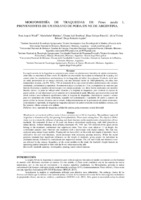Morfometría de traqueidas de Pinus taeda L provenientes de un ensayo de poda en NE de Argentina
Morphometry of tracheids of Pinus taeda L from a pruning test in NE de Argentina
Date
2019-09-01Author
Winck, Rosa Ángela
Martínez, María Isabel
Romberg, Elianne Itatí
Fassola, Hugo Enrique
Bohren, Alicia Violeta
Aquino, Diego Rolando
Metadata
Show full item recordAbstract
La región noreste de la Argentina se caracteriza por contar con plantaciones forestales de rápido crecimiento, entre ellas se encuentra el Pinus taeda. El objetivo de este estudio fue evaluar la influencia de la poda y del estrato sobre las características morfométricas de las traqueidas del árbol. Se evaluaron 18 árboles de16 años de edad, proveniente de un ensayo silvícola, con una densidad inicial de 1660 plantas/ha, sin raleo, tres tratamientos de poda, con 0%, 50% y 70% de remoción de la copa verde del árbol, perteneciente a los estratos dominante, codominante y suprimido. Se tomaron rodajas a la altura de 1,3 m, se prepararon las muestras que fueron observadas y medidas al microscopio con cámara acoplada. Los datos fueron analizados con modelos lineales mixtos. La poda no influyó sobre el ancho y la longitud de traqueidas, pero sí afectó al espesor de pared celular, el cual disminuyó con el aumento de la intensidad de poda. Mientras que la posición social del árbol (estrato) tuvo influencia significativa sobre la longitud de traqueidas, obteniéndose mayores valores para los ejemplares del estrato dominante, seguidos del codominante y suprimido. El ancho y espesor de pared celular no fueron afectados por el estrato. Independientemente de la pertenencia al estrato dominante, codominante o suprimido, la longitud de traqueidas presentó un patrón creciente desde médula a corteza, con los menores valores cercanos a la médula. The northeast region of Argentina is characterized by fast-growing forest plantations, Pinus taeda among them. The objective of this study was to evaluate the influence of pruning and stand structure on the morphometric characteristics of tree tracheids. We evaluated 18 trees of 16 years old, from a silvicultural stand essay, with 1660 plants/ha as initial density, without thinning, three pruning treatments 0%, 50% and 70% removal of the green crown belong to the dominant, codominant and suppressed strata. Tree slices were taken at 1.3 m height, the conditioned samples were observed and measured with a microscope with digital camera. The data was analyzed using mixed linear models. Pruning did not have effect on the width and length of tracheids, but it affected to the cell wall thickness, which decreased with increasing pruning intensity. While the social position (stratum) had significant influences on the length of tracheids, given greater for individual in dominant stratum, followed by codominant and suppressed stratum. The cell wall width and thickness were not affected by the stratum. Regardless of the social position in the stand, the tracheid’s length showed an increasing pattern from pith to bark with the lower values near to the pith.
Collections
The following license files are associated with this item:




